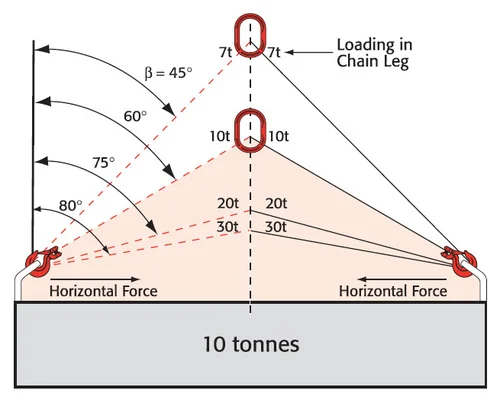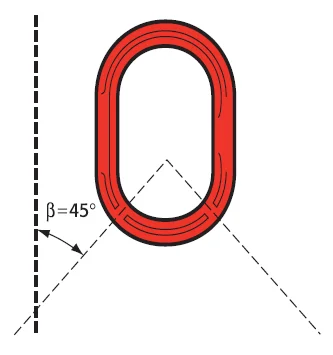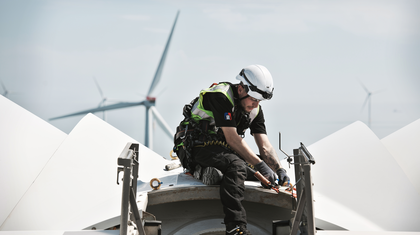Chain Slings Load Chart
Here you will find key factors when calculating the working load limit (WLL) of chain slings, such as the angles of use, safe operating temperatures and grade.
Please only use this information for reference.
|
Chain Slings |
||||||||
|
Grade 8 working load limits are in accordance with BS EN 818-4:1996+A1:2008 Working Load Limit Tonnes |
||||||||
| Chain Diameter | Single leg | Two Leg | Three and Four leg | Endless | Chain Diameter | |||
 |
 |
 |
 |
 |
 |
|||
| 0° < ß ≤ 45° | 45° < ß ≤ 60° | 0° < ß ≤ 45° | 45° < ß ≤ 60° | |||||
| mm | Grade | Factor 1 | Factor 1.4 | Factor 1 | Factor 2.1 | Factor 1.5 | Factor 1.6 | mm |
| 7 | 8 | 1.5 | 2.21 | 1.5 | 3.15 | 2.24 | 2.5 | 7 |
| 7 | 10 | 2 | 2.8 | 2 | 4.2 | 3 | 3.2 | 7 |
| 8 | 8 | 2 | 2.8 | 2 | 4.2 | 3 | 3.2 | 7 |
| 10 | 8 | 3.15 | 4.25 | 3.15 | 6.7 | 4.75 | 5 | 10 |
| 10 | 10 | 4 | 5.6 | 4 | 8.4 | 6 | 6.4 | 10 |
| 13 | 8 | 5.3 | 7.5 | 5.3 | 11.2 | 8 | 8.5 | 13 |
| 13 | 10 | 6.7 | 9.5 | 6.7 | 14 | 10 | 10.7 | 13 |
| 16 | 8 | 8 | 11.2 | 8 | 17 | 11.8 | 12.5 | 16 |
| 16 | 10 | 10 | 14 | 10 | 21.2 | 15 | 16 | 16 |
| 19 | 8 | 11.2 | 16 | 11.2 | 23.6 | 17 | 18 | 19 |
| 19 | 10 | 14 | 20 | 14 | 30 | 21 | 22.4 | 19 |
| 22 | 8 | 15 | 21.2 | 15 | 31.5 | 22.4 | 22.4 | 22 |
| 23 | 8 | 16 | 23.6 | 16 | 35.5 | 25 | 26.5 | 23 |
| 23 | 10 | 21 | 29.5 | 21 | 44 | 31.5 | 33.5 | 23 |
| 26 | 8 | 21.2 | 30 | 21.2 | 45 | 31.5 | 33.5 | 26 |
| 26 | 10 | 27 | 38 | 27 | 57 | 40 | 43 | 26 |
| 32 | 8 | 31.5 | 45 | 31.5 | 67 | 47.5 | 50 | 32 |
| 32 | 10 | 40 | 56 | 40 | 85 | 60 | 65 | 32 |
|
NEVER EXCEED THE WORKING LOAD LIMIT (WLL) MARKED ON THE SLING When slings are used in a choke hitch, reduce the WLL by 20% |
||||||||
Chain Slings restrictions on the angle of use - Variation of chain sling leg loading with leg angle for a load of 10t.

All multi-leg chain slings exert a horizontal component of force, which increases as the angle from the vertical becomes greater. No chain sling should be used if the angle from the vertical exceeds 60˚, as beyond this point the forces in the legs drastically increase.
DO NOT USE MULTI-LEG CHAIN SLINGS AT ANGLES WITHIN THE SHADED AREA (as seen in the diagram above).
Angles of less than 15˚ should also be avoided as these can lead to the load becoming unstable.
If the sling angles are on or inside the guidelines the sling is within the angle range
Limitations on use
Due to risk of embrittlement, KUPLEX slings should not be used in acid or caustic solutions nor in heavily acidic or caustic laden atmospheres. In uncertain conditions consult Certex.
KUPLEX slings must not be heat treated, galvanised, plated, coated or subject to any process involving heating or pickling. Each of these processes can have dangerous effects and will invalidate the manufacturers certificate.


KUPLEX slings may be used in temperatures down to -40°C with no reduction in the working load limit. The use of KUPLEX chain slings within the permissible temperature range in the table shown does not require any permanent reduction in working load limit when the chain sling is returned to normal temperatures. A sling accidentally exposed to temperatures in excess of the maximum permissible should be withdrawn from service immediately and returned to Certex for thorough examination.
When using Kuplex slings in exceptional hazardous conditions, the degree of hazard should be assessed by a competent person and the working load limit adjusted accordingly. Examples include the lifting of persons and lifting of potentially dangerous loads such as molten metals, corrosive materials or fissile material and certain offshore activities.





